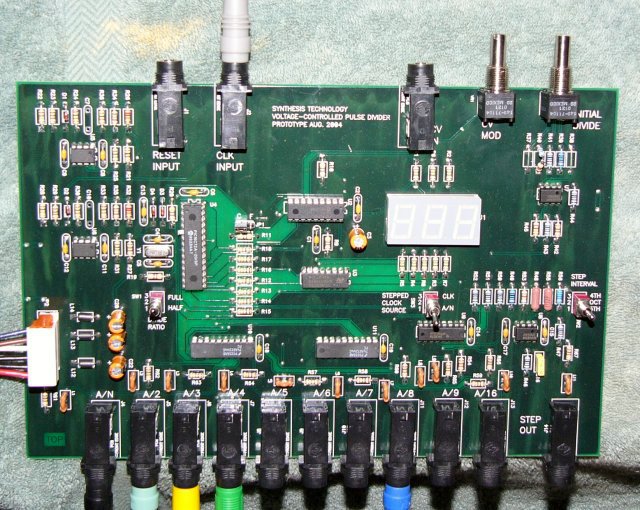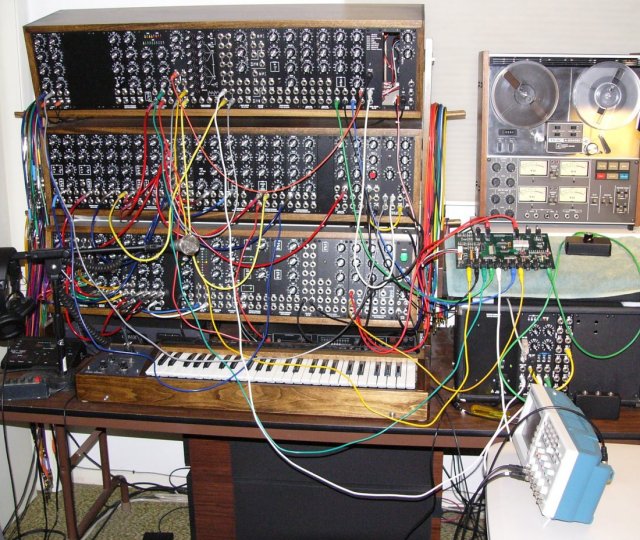 |
Synthesis Technology |
|
This page describes the my Beta evaluation of a prototype MOTM-730 module.
I received the prototype from Paul and set it on my ARP sequencer with a 6 pin power cable into my top cabinet. I am using a PowerOne HCAA-60W-A power supply with a MOTM-990 distribution board. The MOTM-730 had a lot more jacks than I was expecting with a total of 11 for the divider outputs and 3 for inputs. There are also 2 potentiometers, three switches, a jumper strap, and the 3 digit LED display.

Sequencer
I first setup the MOTM-730 as
a sequencer by attenuating and mixing together several of the divider outputs and running these through a quantizer
to my MOTM-300 and to my PSIM. The saw output of the MOTM-300 was
used to drive my MiniWave. I used A/2, A/4, and A/7 outputs and tweaked
the gains until I got a pattern that I liked. A/3 selects two banks in the
MiniWave. A/8 is used to FM the LFO that drives the clock input on the MOTM-730. I
used A/21 (variable divider) with a bit of lag to control the FM on a MOTM-440 filter used for the MiniWave output.
I loaded a CV to MIDI program on the PSIM and drive my Roland SC-7 (Sound Canvas) and mixed this output with the MiniWave through a spring reverb. I have a bit of lag on the quantizer so it creates MIDI glissandos as it tracks the slowly changing CV.
Here is a photo of the patch setup and the prototype MOTM-730.

Here are some sound samples from this setup:
![]() Sequence-1
Sequence-1
MOTM-730 Sequence patch. A/5 controls MIDI octave range and Step Out controls MIDI Program Change. You can hear it change through several of
the lower GM patches.
![]() Sequence-2
Sequence-2
This is the same sequence with a preselected MIDI program change.
Step Out
I spent some time with an oscilloscope looking at the various waveforms and controls to understand their function. I spent time measuring and trying the Step Out function. It operates in 4ths, 5ths, and octaves. I setup a couple of patches and found this to be quite interesting. I sent Paul the measurements I had taken on this particular prototype.
I used some of the outputs to control the divisor for the A/N output to generate different pulse streams. I used this to control my VCOs but did not record any of the sound samples.
Hammond Organ
I mixed together several of the outputs to form a Hammond-like tonewheel divider. I used my JLH-822 module to step up my VCOs to a +3 octave and used this as the highest frequency output and the clock to the MOTM-730. I ran this output through a VCA controlled by an ADSR to simulate the percussion effect on the Hammond. I used another VCA on the output of the mixer controlled with an ADSR organ envelope. I mixed together A, A/2, A/3, A/4, A/8 and A/12 for the tonewheels and I mixed the output of a third ADSR to create the key-click.
I'm not used to monophonic Hammond playing but here is the sound sample!
![]() Hammond
Hammond
MOTM-730 Hammond patch.
Final Thoughts
I was able to spend a couple of quality evenings with the MOTM-730. I had written a program for my PSIM that will divide an LFO input clock by pre-selected set of divisors and expected the MOTM-730 to be similar in functionality. I was surprised by the number of outputs and the CV controlled divisor functionality. I successfully did an A/B comparison of the MOTM-730 4ths step output with a patch based on my sequencer and quantizer. I was surprised by how complex of a patch it took to duplicate this functionality since my sequencer does not have the range of the MOTM-730. There is a lot of functionality in the step output that could be explored more creatively than I had time for.
I spent some time looking at the outputs with my oscilloscope. I wanted to verify some of the functionality such as when the divisor CV control affects the waveform (at the end of the current cycle) and the functionality for the jumper straps.
The Full / Half selection is interesting and gives you many fractional dividers. It took me a bit to remember that A/2 is really A when in this mode.
I would like to have spent more time experimenting with this but I had to pack up the unit and send it on to the next individual for testing.